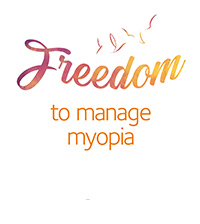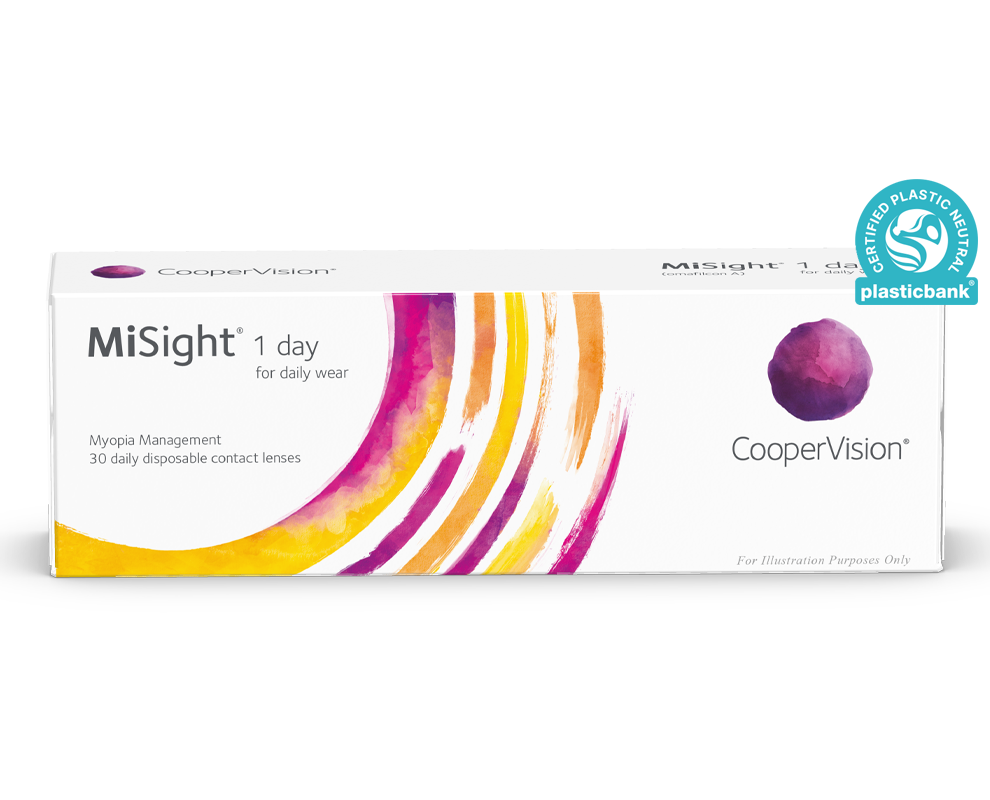Description
MiSight® 1 day contact lenses are specifically designed for children with myopia.1-3
Features and Benefits
- Tested and proven to reduce the worsening of myopia by half†‡2,4
- Effective for nearly all children with myopia‡2
- ‘Always on’ myopia control helps to achieve the required wear time§5,6
- ActivControl® technology is backed by the MiSight® 1 day 7-year clinical trial7
- Works at any age treatment starts and myopia control benefits are retained after treatment endsצ3,4,8
- Child-friendly, easy to fit and easy to use**1,9
- Ideal for children’s active lifestyles§5
- Contact lenses can help improve children’s self-perception of their appearance, athletic competence, and social acceptance10

| ActivControl® TechnologyActivControl® Technology helps control both axial length and myopia worsening in children while fully correcting refractive error.1 |
Myopia management
Childhood myopia is a chronic and progressive disease growing in both prevalence and severity.11 There is an urgency to act now as myopia worsening is irreversible and 1 in 2 children born today could have myopia by age 20.11,12 Addressing a child’s myopia early helps to reduce the risk of myopia-related vision complications later in life, including retinal detachment, myopic maculopathy, glaucoma, and cataracts.13-16
Product Details
-6.00 to -0.25 DS (0.25 steps)
Packaging images for illustration purposes only.
Plastic used in participating CooperVision soft contact lens products is determined by the weight of plastic in the blister, the lens, and the secondary package, including laminates, adhesives, and auxiliary inputs (e.g. ink). The determination does not include plastic used during the manufacturing process for both these products and their packaging.17
For the device safety, warnings, precaution, and local regulatory information, please refer to the Instruction for use leaflet.
* Compared to a single vision 1 day lens over a 3 year period.
† Using measured and modeled data, pooled across ages (8-17), MiSight® 1 day slowed myopia progression by an average of approximately 50%.
‡ 90% of myopic eyes respond to MiSight® 1 day treatment; ages 11-15 at initiation of treatment, n=90.
§ In clinical study, mean weekday wear time increased from 12.8 hours/day at 6-months to 13.9 hours/day at 6-years with a mean of >6.5 days/week.
◊ Children with myopia fit with MiSight® 1 day contact lenses ages 8-15 continued to experience slowed myopia progression as long as they remained in treatment.
¶ 12 months post-treatment, evidence indicates that no accumulated myopia control benefits were lost following 3 or 6-years of MiSight® 1 day wear (on average, for children aged 8-15 at start of wear). Instead, eye growth reverted to expected, age average myopic progression rates.
** Initial CL BVP selection and observation of fit follows same fitting protocol for single vision CLs; fit success rate same with MiSight® 1 day and Proclear® 1 day.
References:
1. Chamberlain P, et al. A 3-year randomized clinical trial of MiSight® lenses for myopia control. OVS. 2019; 96(8):556-567
2. Chamberlain P, et al. Long-term Effect of Dual-focus Contact Lenses on Myopia Progression in Children: A 6-year Multicenter Clinical Trial. OVS 2022 Mar 1;99(3):204-212.
3. Chamberlain P, Arumugam B, et al. Myopia progression on cessation of Dual-Focus contact lens wear: MiSight 1 day 7 year findings. OVS 2025 In Press;98:E-abstract 210049.
4. Arumugam B et al. Modelling Age Effects of Myopia Progression for the MiSight 1 day Clinical Trial. IOVS 2021;62(8):2333.
5. Woods J et al. Ocular health of children wearing daily disposable contact lenses over a 6-year period. CLAE 2021 Aug;44(4):101391.
6. Lumb E, et al. Six years of wearer experience in children participating in a myopia control study of MiSight® 1 day. CLAE 2023; 46(4): 101849.
7. CVI data on file, 2025.
8. Hammond D, Arumugam B, et al. Myopia Control Treatment Gains are Retained after Termination of Dual-focus Contact Lens Wear with no Evidence of a Rebound Effect. OVS 2021;98:E-abstract 215130.
9. CVI data on file 2018
10. Walline J, et al. Randomized trial of the effect of contact lens wear on self-perception in children. Optom Vis Sci. 2009 Mar;86(3):222-32.
11. Holden BA, Fricke TR, Wilson DA, et al. Global prevalence of myopia and high myopia and temporal trends from 2000 through 2050. Ophthalmology. 2016;123(5):1036-1042.
12. K. Zadnik et al. Factors Associated with Rapid Myopia Progression in School-aged Children. IOVS 2004;45(13):2306.
13. Xu L et al. High myopia and glaucoma susceptibility, the Beijing Eye Study. Ophthalmology. 2007;114(2):216-20.
14. Flitcroft DI. The complex interactions of retinal, optical and environmental factors in myopia aetiology. PRER 2013;31(6):622-60.
15. Younan C, et al. Myopia and incident cataract and cataract surgery: the blue mountains eye study. IVOS 2002;43(12):3625-3632.
16. Chen SJ, et al. Prevalence and associated risk factors of myopic maculopathy in elderly Chinese: the Shihpai eye study. IOVS 2012;53(8):4868-73.
17. CVI data on file, 2024.
SA14191 / APP143369







